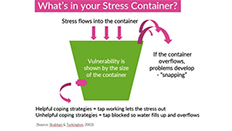Mental health and wellbeing
By Wendy Strohm, CIEA Fellow
 Recent events have placed an increasing emphasis on the importance of our psychological wellbeing. A pandemic, with lockdown, time away from education, work, friends and family has had wide-reaching impact, and this will be different for each of us. The World Health Organisation defines mental health as a state of wellbeing in which everyone can realise their own potential, cope with the usual stresses of life, work well and contribute to the community. NHS England explains 1 in 4 adults and 1 in 10 children experience mental illness. So how do we support each other and those in our pastoral care?
Recent events have placed an increasing emphasis on the importance of our psychological wellbeing. A pandemic, with lockdown, time away from education, work, friends and family has had wide-reaching impact, and this will be different for each of us. The World Health Organisation defines mental health as a state of wellbeing in which everyone can realise their own potential, cope with the usual stresses of life, work well and contribute to the community. NHS England explains 1 in 4 adults and 1 in 10 children experience mental illness. So how do we support each other and those in our pastoral care?
Understanding how our mental health can be affected is important. Mental Health England give us a model for this – the Stress Container.

Imagine a container where ‘stress’ is added over time. Some of us have bigger containers than others, or the stress added is of a different size for me than it is for you. The container might keep filling up until it overflows, and this is where problems can occur. My container may fill more quickly than yours. Now imagine there is a tap in the container which we can open or close. The tap might be blocked with ‘unhelpful coping strategies’ e.g. working harder, sleeping less, etc. But the tap can be opened with ‘helpful coping strategies’ e.g. time to self, exercise, fresh air, talking to someone.
The most important thing is not to ignore it. You would not ignore a physical injury or illness so the same must apply to someone who may be struggling with mental health. There are lots of useful videos in the public domain that can be used appropriate to your context. I particularly like Talking Mental Health from National Centre for Children and Families designed for a younger audience. The BBC 3 Mental Health video series is also really useful for further insight – see the list of episodes HERE.
Support steps
- The first step to supporting another is to notice changes. Is the individual unusually quiet, angry, despondent, busy, insular, tired, and so on.
- The second step is to initiate a conversation. “I’ve noticed that you seem quieter than usual John. Would you like to talk it through?” Make sure you find a private space and that you allow time for the conversation.
- The third step is to listen. Be open and empathetic – take it seriously. Listening, giving your attention, and acknowledging the situation. Offering advice or problem solving is not helpful at this stage – you are simply there to listen. Reassuring that their feelings are common and that there are many sources of support available.
- The fourth step is to ask if John has experienced anything like this before and to ask about previous coping mechanisms. Is there someone at home/work/school who can support? Where children or vulnerable adults are concerned there may be safeguarding concerns and you should follow your organisational process in this instance.
- The fifth step is linking to support available. These might be on site, provided by work or education resources. You might also consider suggesting their GP. You can also link to on-line resources.
There are a huge range of mental health charities, organisations and support groups. Many can be found on the NHS website . Mind has a wealth of on-line resources and their helpline will provide support as well as link to more local services.
- Wendy Strohm trained as a Mental Health First Aider and has lived experience of a mental health diagnosis.

